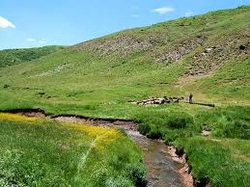
Based from her 100,000 finds, Dutch archaeologist Eva Kaptijn discovered that Jordan’s Zerqa Valley had been consecutively irrigated and inhabited for over 13,000 years. However, it was not only communities that established irrigation systems; irrigation systems also built communities.
Kaptijn had abandoned excavating and assumed collecting. Together with colleagues, she applied a thorough field exploration method: 15 metres apart, the scientists would walk ahead for about 50 metres. As they advance, the group would pick up earthenware. On the way back, they would collect all other materials. This resulted to over 100,000 various finds that date back from around 13,000 years ago to just several decades ago.
On further studies regarding the finds and its locations, researchers succeeded in calculating the span of habitation at the Zerqa Valley throughout the past million years. The area of their study is known as the Zerqa Triangle, which is located along the River Zerqa and constitutes a section of the Jordan Valley. Researchers found out that the Zerqa triangle had been populated intermittently for thousands of years; however, the habitation was found to have been greatly dependent on the irrigation techniques used in the area. Though the valley’s soil was extremely rich, the area usually did not experience enough rainfall to sustain crops without additional irrigation.
Kaptijn had abandoned excavating and assumed collecting. Together with colleagues, she applied a thorough field exploration method: 15 metres apart, the scientists would walk ahead for about 50 metres. As they advance, the group would pick up earthenware. On the way back, they would collect all other materials. This resulted to over 100,000 various finds that date back from around 13,000 years ago to just several decades ago.
On further studies regarding the finds and its locations, researchers succeeded in calculating the span of habitation at the Zerqa Valley throughout the past million years. The area of their study is known as the Zerqa Triangle, which is located along the River Zerqa and constitutes a section of the Jordan Valley. Researchers found out that the Zerqa triangle had been populated intermittently for thousands of years; however, the habitation was found to have been greatly dependent on the irrigation techniques used in the area. Though the valley’s soil was extremely rich, the area usually did not experience enough rainfall to sustain crops without additional irrigation.
 RSS Feed
RSS Feed